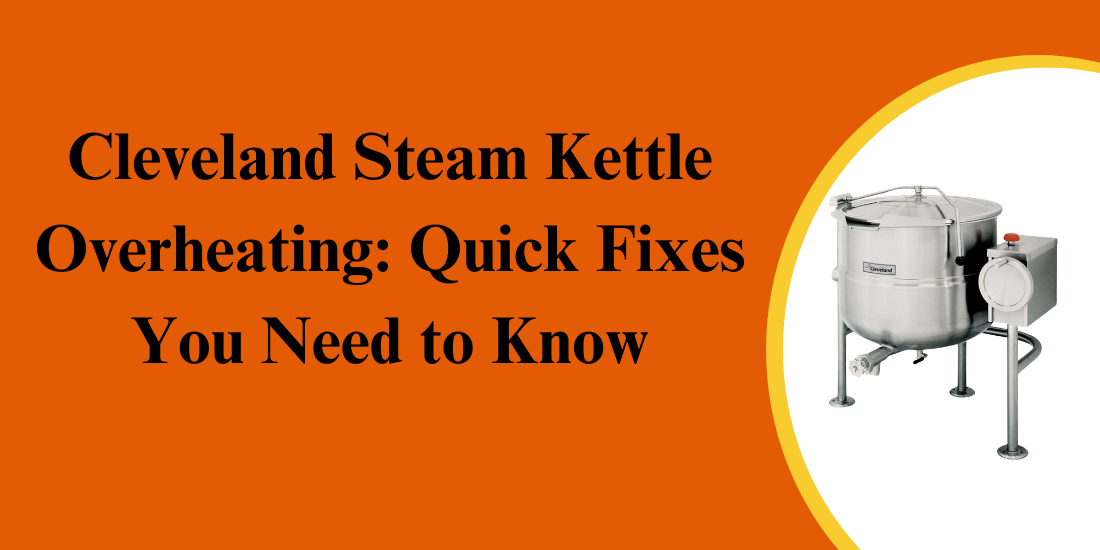
Cleveland Steam Kettles are essential in commercial kitchens, providing efficient cooking for large batches of soups, sauces, and stews. However, overheating can disrupt operations, waste ingredients, and lead to costly repairs. Many overheating issues stem from faulty Cleveland parts within the kettle’s system. In this article, We’ll explore the common causes of overheating and provide workable fixes to deal with the issue before it results in expensive damage or downtime. You can maintain the effectiveness of your kitchen and keep your steam kettle operating smoothly by being aware of these problems.
Common Causes of Overheating in Cleveland Steam Kettle and Quick Fixes
Several factors can contribute to Cleveland Steam Kettles’s overheating. Understanding the root cause will allow you to resolve the problem efficiently. Below are the most common causes of overheating, along with quick fixes to address each one.
- Defective Thermistor
The internal heat is measured by the thermistor and data is sent to the control system; the kettle is then warmed or cooled accordingly. The kettle may overheat if the thermistor becomes defective and provides wrong temperature readings.
Fix:
- Wait until the kettle cools down before inspecting the thermistor.
- Use a multimeter to test the thermistor to make sure it’s working. Replace it with a new one that meets the kettle’s requirements if your current one is broken or doesn’t demonstrate continuity.
- An accurate reading of temperature and preventing overheating are dependent upon a properly functioning thermistor.
- Faulty Temperature Control
The temperature control system is designed to keep the desired cooking temperature. If the kettle malfunctions, it will continue to heat beyond the set temperature and overheat.
Fix:
- Make sure the temperature settings are at the given manufacturer’s recommendations.
- Examine the temperature control sensors for any damage or loose connections. It will need to be replaced if the thermostat breaks or the sensor malfunctions.
- Use a multimeter to check the thermostat. To restore appropriate temperature regulation, replace it if it is broken.
- Damaged Control Board Relay
The control board relay just controls the amount of power to the various components such as the heating elements. If the relay is broken, the kettle will overheat since it will keep running even after the temperature is at the desired level.
Fix:
- Unplug the kettle from the power source and turn off the kettle.
- Look for signs of damage to the control board relay, like burns or scorch marks.
- Check the relay’s functionality with a multimeter. If it’s not the correct part, replace it with the correct part.
- To avoid overheating, a working control board relay properly turns the heating components on and off.
- Steam Pressure Imbalance
To keep a constant cooking temperature, it’s important to maintain proper steam pressure. The kettle overheats if the steam pressure is too high or fluctuates. Such could be due to a broken pressure regulator, blocked steam valves, and broken pressure sensors.
Fix:
- Get a look at the pressure gauge to make sure it’s all within the recommended range.
- Look for leaks or signs of malfunction on the pressure regulator valve. It requires cleaning or replacement if necessary.
- Allow for proper steam release and relieve pressure by clearing blockages in the steam vents.
- Balanced steam pressure ensures proper temperature control and that the steam doesn’t overheat.
- Low Water Levels
Steam kettles require a proper water level. If the water level is too low the heating elements will run without enough water that produce steam, and it will overheat.
Fix:
- Regularly check the water levels before each use to ensure they are adequate for steam production.
- Examine the water level sensor for any indications of accumulation or malfunction, and replace or clean it as necessary.
- If your kettle has an automatic water fill system, ensure it’s functioning properly to maintain correct water levels.
- Proper water levels prevent overheating by ensuring the kettle’s heating elements are not running dry.
- Clogged or Blocked Steam Vents
The kettle relies on steam vents to get excess pressure out. If the vents are blocked or clogged then the pressure inside the kettle can rise to dangerous levels and over heat.
Fix:
- Look into the steam vents to make sure none are blocked, like bits of food or mineral buildup.
- If you don’t have a soft brush, clear the vents of any debris using compressed air..
- If vents are damaged they should be replaced to ensure proper steam flow and pressure regulation.
- This keeps the steam vents clear so that the kettle can release excess pressure without overheating.
- Improper Settings or Operation
Overheating can sometimes occur because the kettle is not used properly. Overheating can occur if you set the temperature too high, overload the kettle, or don’t follow the manufacturer’s guidelines.
Fix:
- Do not overload the kettle. Always follow the manufacturer’s limits for capacity to achieve even heating.
- Depending on the type of food that you are preparing you can adjust the temperature settings.
- If the kettle has been running for a while, let it cool before continuing.
- This makes sure the kettle operates safely, at safe parameters, and the risk of overheating is reduced.
Cleveland Steam Kettles can overheat for a variety of reasons, but with the right knowledge and quick fixes, you can fix these problems quickly. Regular maintenance, correct operation, and timely repairs will prevent overheating, extend the life of your equipment, and reduce the possibility of expensive repairs and downtime. If the problem continues or you aren’t sure what is wrong, it’s always a good idea to have a professional technician take a look to ensure your kitchen is operating at optimal performance.







